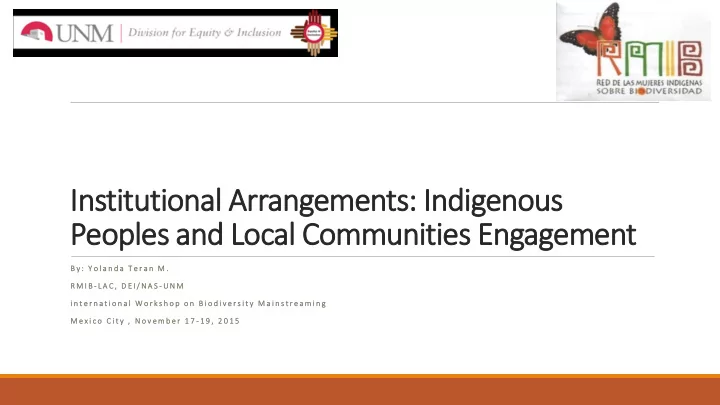

Institutional Arrangements: Indigenous Peoples and Local Communities Engagement B y : Y o l a n d a T e r a n M . R M I B - L A C , D E I / N A S - U N M i n t e r n a t i o n a l W o r k s h o p o n B i o d i v e r s i t y M a i n s t r e a m i n g M e x i c o C i t y , N o v e m b e r 1 7 - 1 9 , 2 0 1 5
Pachamama, , Mother Earth “For Indigenous Peoples from Ecuador, the Pachamama (Mother Earth) is the mother who gives the life to men, animals, plants and the nature. She is the principal base for the development of life and culture. “…The land is our mother, she is not merchandise, she is the integral part of our life, and she is our past, present and future…”. (Personal Communication, CONAIE, June 24, 1996)
Indigenous Epistemology Includes entire systems of knowledge and relationships with the cosmos, with us and with the environment. Indigenous Epistemology refers to our cultures, worldviews, times, languages, stories, spiritualties and our places in the cosmos (Cajete, 2000, Mamani, 2008, Montaluisa, 1988, Ramirez, 2008, Wilson, 2008). Among Indigenous Peoples, a song, story, or medicinal knowledge has a reciprocal relationship and connection with particular human beings, animals, plants, and places (Cajete, 1986).
Kichwa Epistemology The Universe of the Andes Cycles of Life and Agriculture
Ayllu/ Community Mother Wellbeing, Indigenous Earth, Sumak Authorities Pachamama kawsay Customary Law
Respect Solidarity Trust Community Collective Reciprocity rights Oral Care tradition
Policies Chapter Fourth: Rights of communities, pueblos and nationalities Art. 57: Collective rights of IP Art. 57.5: 57.7 (PFIC, MAE & IEPI brochure in Kichwa and Shuar languages); 57.21 National Assembly and the Nagoya Protocol Chapter Seventh Rights of the Nature, Pachamama : Art. 71, 73 The Constitution from Bolivia (Chapter for Mother Earth) Regional Decision 391 (CAN: Colombia, Ecuador, Peru and Bolivia) UNDRIP - Article 29 and 31 1. Indigenous Peoples have the right to the conservation and protection of the environment and the productive capacity of their lands or territories and resources. States shall establish and implement assistance programs for Indigenous Peoples for such conservation and protection, without discrimination.
Challenges Land, territories and waters tenure Extractive industries (destruction of flora, fauna, culture, language …) Sustainable development with identity Political will and good faith for creating coherent and inclusive policies, regulations, norms related to biodiversity taking in consideration the cultural diversity Clear roles of the involved social actors Inclusion of customary law and traditional knowledge and practices, the ecosystem role (holistic view) Strong social safeguards to ensure our survival and Mother Earth’s too (FPIC, MAT, BS, veto, community protocols, the protection of TK) Use of cultural appropriate tools, methodologies and time Intercultural teams and framework for biodiversity mainstreaming (intergenerational and multidisciplinary) Disaggregated data and indicators of IPLCs (policy making)
Challenges Financial resources for sustainable participation and implementation (the continuation of processes) Capacity building at all levels among IPLCs and with states (for instance the RMIB-LAC work since 2006) Women and youth inclusion Full and effective participation at local, national, regional levels to achieve through an intercultural way the mainstreaming of biodiversity Recognition to CBD for IPLCs inclusion (WG8j, Indigenous Co- chair, IIFB Advisory Body…) Increase the participation at CBD meetings, intersessional meetings, WG8j, SBSTTA, SPI, Nagoya Protocol, benefit sharing, National Plans) Mainstreaming in the implementation of CBD Gender Plan????
Yupaychanimi!!! Many Thanks Mexican Government The Secretariat of CBD Division of Equity and Inclusion , UNM Department of Native American Studies, UNM The University of New Mexico. USA Indigenous Women Network on Biodiversity from Latin America and the Caribbean, RMIB- LAC International Indigenous Forum on Biodiversity, IIFB Andes Chinchasuyu, Ecuador
Recommend
More recommend